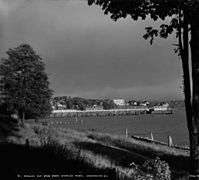English Bay (Vancouver)


English Bay is located in Vancouver, British Columbia, Canada, west of the downtown peninsula and False Creek. It consists of the south side of the Burrard Inlet, extending from Point Grey in the southwest to Prospect Point in the northeast.[1]
Location
English Bay Beach, near the city's West End residential neighbourhood, is the most popular sunbathing, swimming, and sunset-watching beach in the downtown Vancouver area. Other downtown beaches facing English Bay include Sunset Beach, Second Beach, and Third Beach. Along the south shore of the bay lie Kitsilano Beach, Jericho Beach, the Spanish Banks beaches, and Locarno Beach, while on the North Shore are Ambleside Beach and various smaller cove-beaches in the city of West Vancouver. English Bay beaches are all major tourist attraction to visitors all year long, with the peak season being late summer.
The Vancouver Seawall runs all the way around English Bay from Stanley Park in the northeast around False Creek at Point Grey facing the Strait of Georgia in the southwest. This is a favourite destination for walkers, runners, bicyclists, and roller-bladers. (Note: the Seawall is one-way for cyclists and roller-bladers, running counter-clockwise from just east of Lions Gate Bridge to Third Beach.)
English Bay Beach is host to a number of public events. The Celebration of Light is a fireworks competition that is held for two weeks every summer (usually the last week in July and first week in August). While this competition often struggles to secure funding, it has successfully run since 1990 and is the largest off-shore fireworks display in the world. Each winter it is the host of Vancouvers' annual Polar Bear Swim and each summer the Vancouver Pride Parade and Festival is held on English Bay Beach.
History
In the late 19th and early 20th centuries, English Bay Beach was home to Vancouver's first official lifeguard, the legendary Joe Fortes, who taught hundreds of the city's early residents how to swim, and patrolled the beach from his cabin on its shore. Today, the waters of the bay are often dotted with hundreds of small pleasure boats, as well as huge freighters waiting at anchor to load cargoes at Vancouver's port.
The beach was the site of an oil spill in Vancouver on April 8, 2015. The official cause of the spill has not been confirmed, but at least 2700 litres of "bunker fuel" are known to have escaped from a cargo ship into the bay.[2] The highly toxic oil[3] later washed up on nearby beaches, creating a slick 15–20 cm thick. At least twenty seabirds were injured or affected by the spill,[4] but the full extent of any environmental and economic damage is unknown at this early stage.[5][6] The federal government was criticized for its response to the spill, including the delay in notifying the public of the health hazard, by the mayor and premier, environmental scientists, and an international shipping expert.[7][8] Coast Guard officials defended the response, with regional director Assistant Commissioner Roger Girouard saying, "it was exceptional".[9]
The beaches were tested and most were reopened following a ten-day closure. While the water and soil at most of the beaches tested was found not to have harmful levels of oil present, the government cautioned that "small amounts" of oil may remain, and urged people to be aware of the possible hazard and avoid contact with any oil. The reopened beaches will continue to be tested and the need for further cleanup assessed as needed.[10]
Pictures
 Looking along English Bay Beach in the West End.
Looking along English Bay Beach in the West End. English Bay at sunset
English Bay at sunset English Bay Pier from Stanley Park
English Bay Pier from Stanley Park Sunset on the inuksuk at English Bay
Sunset on the inuksuk at English Bay
References
- ↑ http://apps.gov.bc.ca/pub/bcgnws/names/10002.html
- ↑ http://www.cbc.ca/news/canada/british-columbia/vancouver-oil-spill-reaches-west-vancouver-s-sandy-cove-1.3027605
- ↑ http://www.cbc.ca/news/canada/british-columbia/what-is-bunker-fuel-1.3026531
- ↑ CBC News on TV
- ↑ http://www.vancourier.com/news/vancouver-oil-spill-might-be-bigger-than-expected-1.1823672
- ↑ http://www.cbc.ca/news/canada/british-columbia/vancouver-oil-spill-could-have-far-reaching-impacts-expert-1.3027976
- ↑ "Oil spill response by coast guard blasted by Vancouver mayor, B.C. premier". CBC News. April 10, 2015.
- ↑ http://www.cbc.ca/news/canada/british-columbia/toxic-fuel-spill-in-english-bay-is-wake-up-call-for-port-says-marine-expert-1.3027241
- ↑ http://www.vancourier.com/news/feds-on-the-offensive-over-english-bay-fuel-spill-1.1820657
- ↑ http://www.news1130.com/2015/04/19/most-vancouver-beaches-have-now-been-re-opened-following-the-fuel-spill/
External links
Coordinates: 49°17′00″N 123°09′15″W / 49.28333°N 123.15417°W
| Wikimedia Commons has media related to English Bay. |
